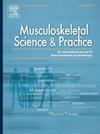患有肌肉骨骼疾病的现役军人康复不良的预后因素:一项荟萃分析的系统综述
IF 2.2
3区 医学
Q1 REHABILITATION
引用次数: 0
摘要
军事人员经历慢性肌肉骨骼疼痛的可能性是平民的两倍。识别肌肉骨骼疾病恢复不良的预后因素可能支持量身定制的护理途径的发展,以改善结果。目的探讨现役军人肌肉骨骼疾病患者康复不良的影响因素。设计对预后研究进行系统回顾,包括前瞻性、回顾性和随机对照试验的二次分析。方法检索medline、EMBASE、AMED、PsychInfo、Cinahl、Scopus和SPORTDiscus数据库,检索时间为建库至2025年3月。如果研究评估了患有任何肌肉骨骼疾病的现役军人与恢复结果(疼痛、残疾、工作状态或感知恢复)相关的预后因素,则纳入研究。两名审稿人独立筛选符合条件的研究,并使用预后研究质量(QUIPS)工具评估方法学质量。对多变量数据进行描述性分析,并尽可能进行meta分析。结果本综述共纳入28项研究。与不良短期预后(残疾)最密切相关的因素是初始疼痛严重程度[OR 3.88 (95% CI 1.50-10.07)],其次是男性(结局受限责任)[OR 2.63 (95% CI 1.57-4.40)]。与不良长期预后(限制责任)最密切相关的因素是精神科共病诊断[RR 6.02(95% 4.25-8.51)]。结论评估初始疼痛严重程度和心理压力源可以帮助临床医生识别有不良预后风险的肌肉骨骼疾病军人。了解职业心理压力源与疼痛症状之间的相互作用,可以确定可调整的因素,从而有针对性地改善康复。本文章由计算机程序翻译,如有差异,请以英文原文为准。
Prognostic factors for poor recovery in active-duty military personnel with musculoskeletal disorders: A systematic review with meta-analysis
Background
Military personnel are twice as likely as civilians to experience chronic musculoskeletal pain. Identifying prognostic factors for poor recovery from musculoskeletal disorders may support the development of tailored care pathways to improve outcomes.
Objectives
Identify prognostic factors for poor recovery in active military personnel with musculoskeletal disorders.
Design
Systematic review of prognostic studies including prospective, retrospective, and secondary analyses of randomised controlled trials.
Methods
MEDLINE, EMBASE, AMED, PsychInfo, Cinahl, Scopus, and SPORTDiscus databases were searched from inception to March 2025. Studies were included if they evaluated prognostic factors for association with recovery outcomes (pain, disability, work status, or perceived recovery) in active military personnel with any musculoskeletal disorder. Two reviewers independently screened eligible studies and assessed methodological quality using the Quality in Prognostic Studies (QUIPS) tool. Descriptive analysis of multivariate data was undertaken with meta-analyses performed where possible.
Results
Twenty-eight studies were included in this review. The factor most strongly associated with poor short-term outcome (disability) was initial pain severity [OR 3.88 (95 %CI 1.50–10.07)] followed by male sex (outcome restricted duty) [OR 2.63 (95 %CI 1.57–4.40)]. The factor most strongly associated with poor long-term outcome (restricted duty) was the presence of comorbid psychiatric diagnosis [RR 6.02 (95 % 4.25–8.51)].
Conclusions
Assessing initial pain severity and psychological stressors may help clinicians identify military personnel with musculoskeletal disorders at risk of poor outcome. Understanding the interaction between occupational psychological stressors and pain symptoms may identify modifiable factors that can be targeted to improve recovery.
求助全文
通过发布文献求助,成功后即可免费获取论文全文。
去求助
来源期刊

Musculoskeletal Science and Practice
Health Professions-Physical Therapy, Sports Therapy and Rehabilitation
CiteScore
4.10
自引率
8.70%
发文量
152
审稿时长
48 days
期刊介绍:
Musculoskeletal Science & Practice, international journal of musculoskeletal physiotherapy, is a peer-reviewed international journal (previously Manual Therapy), publishing high quality original research, review and Masterclass articles that contribute to improving the clinical understanding of appropriate care processes for musculoskeletal disorders. The journal publishes articles that influence or add to the body of evidence on diagnostic and therapeutic processes, patient centered care, guidelines for musculoskeletal therapeutics and theoretical models that support developments in assessment, diagnosis, clinical reasoning and interventions.
 求助内容:
求助内容: 应助结果提醒方式:
应助结果提醒方式:


